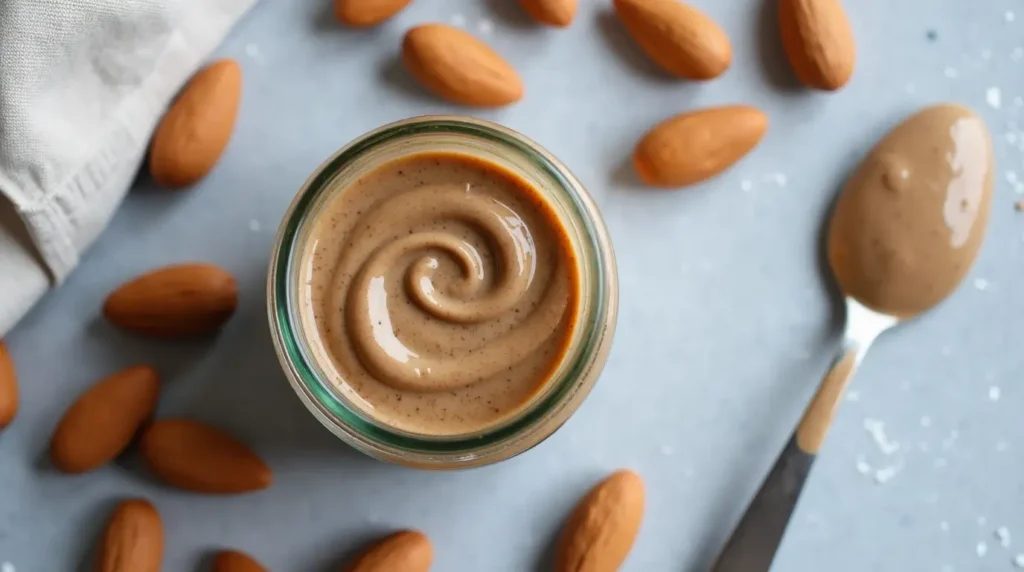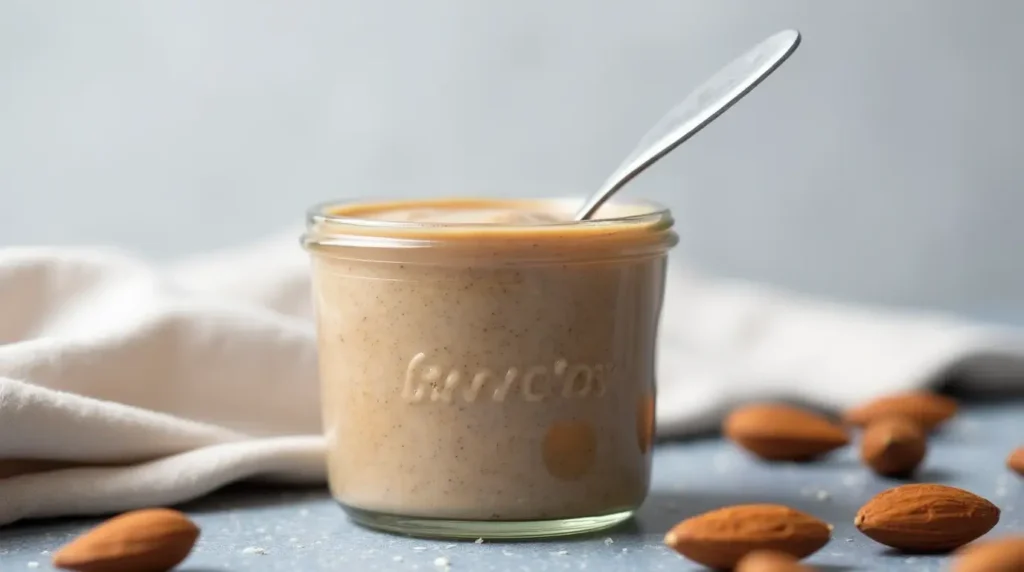Food Processor Almonds and Asian Sauce Recipe
Discover how to make delicious Food Processor Almonds and Asian Sauce Recipe in your kitchen with this guide. It shows you how to use a food processor to turn almonds into a tasty sauce. This will boost your cooking skills and wow your guests.
Making an almond-based Asian sauce is a unique art. It mixes nutrition, taste, and cultural traditions. This recipe is perfect for home cooks and food lovers. It will lead you through each step with care and creativity.
Table of Contents
Key Takeaways
- Learn to create authentic Asian almond sauces using a food processor
- Discover versatile techniques for blending ingredients
- Understand the nutritional benefits of almond-based sauces
- Explore different flavor combinations and variations
- Master the art of sauce consistency and texture

Understanding the Basics of Almond-Based Asian Sauces
Discover the exciting world of almond-based Asian sauces. These tasty condiments are making healthy snacks and plant-based meals even better. Nut butters are changing the game in cooking, adding nutrition and flavor.
Benefits of Using Almonds in Asian Cuisine
Almonds add something special to Asian cooking. They give dishes a creamy texture and a nutty taste. Here are some key benefits:
- More protein for plant-based meals
- Smooth, velvety sauce
- Healthy fats
- Great flavor
Essential Equipment and Ingredients
To make almond-based sauces, you need some key tools and ingredients. Make sure your kitchen has:
| Equipment | Purpose |
|---|---|
| High-powered food processor | Smooth sauce preparation |
| Blender | Alternative sauce mixing |
| Measuring cups | Precise ingredient proportions |
Nutritional Value of Almond-Based Sauces
Almond sauces are full of good stuff. They turn regular meals into healthy snacks easily. They’re packed with vitamin E, magnesium, and protein, making them more than just tasty.
“Almonds are nature’s perfect ingredient – nutritious, delicious, and endlessly versatile.” – Culinary Nutrition Expert
Selecting and Preparing Your Almonds for Processing
Making great nut butter recipes begins with picking the best almonds. Your cooking skills will stand out when you choose top-quality nuts. These nuts add rich flavors to your sauce.
When picking almonds, keep these points in mind:
- Freshness: Choose almonds with a smooth, even color
- Sourcing: Go for organic, non-GMO types when you can
- Texture: Whole, unblemished almonds work best for processing
Getting your almonds ready is key for strong flavors. Roasting almonds can unlock deeper, nuttier notes that make your sauce better. Try these ways to prepare:
- Dry roasting in a skillet for 5-7 minutes
- Oven roasting at 350°F for even heat
- Soaking raw almonds overnight to soften them
“The secret to amazing sauces lies in understanding your ingredients.” – Professional Chef Recommendation
Before you start processing, make sure your almonds are cool and dry. Wipe them with a clean towel to get rid of extra moisture. This helps avoid clumps and makes your nut butter smooth and consistent.

Essential Asian Ingredients for Your Sauce
Making authentic asian sauces needs a good grasp of traditional ingredients. These ingredients turn simple recipes into amazing dishes. Your kitchen appliances are key in mixing these flavors into a tasty sauce, perfect for vegan recipes.
Traditional Asian Seasonings
The base of great asian sauces is in the right seasonings. Make sure your pantry has:
- Tamari or soy sauce
- Rice vinegar
- Sesame oil
- Miso paste
- Gochujang (Korean red chili paste)
Fresh Herbs and Aromatics
Boost your sauce with these ingredients full of flavor:
- Fresh ginger root
- Garlic
- Cilantro
- Green onions
- Thai basil
Liquid Components for Perfect Consistency
Getting the right texture is key for top-notch asian sauces. Think about these liquids:
| Liquid Component | Flavor Profile | Consistency Impact |
|---|---|---|
| Coconut milk | Creamy, rich | Thick, smooth |
| Rice wine | Subtle sweetness | Light, flowing |
| Vegetable broth | Savory undertones | Thin, adaptable |
“The secret to an incredible sauce is balancing flavors and textures with precision.” – Chef Ming Tsai
Your vegan recipes will stand out with these chosen ingredients. They turn simple almond-based sauces into top-notch dishes.
Food Processor Almonds and Asian Sauce Recipe
Making a tasty raw food sauce with almonds is all about precision and knowing your cooking techniques. This simple yet flavorful Asian-inspired recipe will make your plant-based diet more exciting. It turns raw ingredients into a creamy, nutritious sauce.
First, gather your ingredients for this fun culinary journey. The secret to a great almond-based sauce is using top-quality, fresh ingredients. Also, mastering the right food processor techniques is key.

Ingredients You’ll Need:
- 1 cup raw almonds
- 3 tablespoons tamari sauce
- 2 tablespoons rice vinegar
- 1 inch fresh ginger, peeled
- 2 garlic cloves
- 1/4 cup water
Processing Steps:
- Soak almonds in water for 4-6 hours
- Drain and rinse almonds thoroughly
- Add all ingredients to food processor
- Blend until smooth and creamy
The magic happens when you process the ingredients. Pulse initially to break down almonds, then blend continuously for a silky texture. Adjust the water to get the sauce consistency you want.
“Cooking is about passion, creativity, and transforming simple ingredients into something extraordinary.” – Unknown Chef
| Ingredient | Nutritional Value | Benefit |
|---|---|---|
| Raw Almonds | High Protein | Muscle Recovery |
| Ginger | Anti-inflammatory | Digestive Health |
| Garlic | Antioxidants | Immune Support |
Your homemade almond Asian sauce is now ready to make any dish better. Store it in an airtight container in the fridge. Enjoy it within 5-7 days for the best taste and freshness.
Tips for Achieving the Perfect Sauce Consistency
Making smooth and tasty almond-based Asian sauces needs precision and skill. Your creativity can really come through when you get good at blending nut butters. Knowing the right steps can turn simple ingredients into amazing sauces.
Getting the sauce just right is about a few important things. These can take your cooking from good to great.
Processing Techniques for Smooth Results
Here are some expert tips for blending nut butters:
- Start with room temperature almonds for optimal blending
- Process in short, controlled pulses to prevent overheating
- Scrape down sides frequently during blending
- Use a high-powered blender for most consistent results
Pro tip: Let ingredients rest between blending to keep the texture smooth.
Troubleshooting Common Texture Issues
Texture problems can mess up your plans. Here are quick fixes for common sauce issues:
- Grainy texture: Blend longer or add small amounts of liquid
- Too thick: Add more oil or water slowly
- Separated sauce: Blend again with a stabilizer
“Patience and technique are the secret ingredients to perfect sauce consistency.” – Professional Chef
Mastering these tips will help you make almond Asian sauces that wow everyone.

Versatile Ways to Use Your Almond Asian Sauce
Your homemade almond Asian sauce is a game-changer for healthy snacks and plant-based meals. It turns simple dishes into amazing culinary experiences in Asian cuisine.
Here are some creative ways to use your sauce:
- Dipping sauce for fresh vegetable platters
- Marinade for tofu and tempeh
- Drizzle over grain bowls
- Salad dressing base
- Stir-fry flavor enhancer
The sauce is perfect for plant-based meals. It pairs well with different protein options. Its rich, nutty taste adds depth to noodle dishes and roasted vegetables.
| Dish Type | Sauce Application | Flavor Profile |
|---|---|---|
| Buddha Bowl | Drizzle on top | Creamy, tangy |
| Vegetable Skewers | Marinade | Spicy, nutty |
| Soba Noodles | Tossing sauce | Umami, rich |
Pro tip: Try different Asian cuisine ideas to find new flavor mixes. This will show off your almond sauce’s versatility.
“A great sauce can elevate any dish from ordinary to extraordinary” – Chef Martin Yan
Storage and Preservation Methods
Making the perfect almond Asian sauce needs skill and smart storage. Your homemade vegan recipe should be preserved well. This keeps its flavors and nutrients alive. Kitchen appliances help keep your sauce fresh and tasty.
Proper Container Selection
The right storage container is key to keeping your sauce fresh. Glass containers with tight lids are best. They keep flavors in and contaminants out.
- Use clear glass containers with airtight seals
- Select BPA-free containers
- Opt for containers with narrow mouths to minimize air exposure
Shelf Life Guidelines
Knowing how long your almond Asian sauce lasts is important. It affects how long you can enjoy its flavor and nutrition. The storage method you choose impacts its freshness.
| Storage Method | Temperature | Approximate Shelf Life |
|---|---|---|
| Refrigerated | 35-40°F | 5-7 days |
| Frozen | 0°F or below | 2-3 months |
Pro tip: Always use clean utensils when scooping sauce. This prevents bacterial contamination. Also, label your containers with the date you made them to keep track of freshness.
“Proper storage is the secret to maintaining the vibrant flavors of your homemade sauce.” – Culinary Expert
Remember, fresh ingredients and careful handling are essential. They help your almond Asian sauce last longer. Enjoy your delicious, nutritious sauce with confidence!
Customizing Your Sauce: Spice Levels and Variations
Making the perfect almond Asian sauce is like an art of mixing flavors. You can change your homemade sauce to fit your taste and cooking style.
Spice levels are key in making your sauce unique. Start by knowing how spicy you like it. Then, try different ingredients to find your favorite.
- Mild Variation: Use less chili and more sweet elements
- Medium Heat: Incorporate moderate amounts of fresh chili peppers
- Intense Spicy Version: Add habanero or ghost pepper for extreme heat
Exploring different ingredients can take your sauce to new heights:
| Base Ingredient | Alternative Options | Flavor Profile |
|---|---|---|
| Almonds | Cashews, Peanuts | Creamy, Rich |
| Soy Sauce | Tamari, Coconut Aminos | Umami, Lighter |
| Chili Sauce | Sriracha, Gochujang | Intense, Complex |
Pro tip: Always taste and adjust incrementally to achieve your desired flavor balance.
“Cooking is about passion, so don’t be afraid to experiment!” – Unknown Chef
Pairing Suggestions for Your Almond Asian Sauce
Exploring new pairings can make your plant-based diet exciting. Your almond Asian sauce is versatile and can make many dishes taste better. It adds rich, complex flavors.
Main Dish Combinations
Find the perfect match for your almond Asian sauce. It works well with proteins and grains. Here are some tasty ideas:
- Grilled tofu with a generous drizzle of sauce
- Roasted tempeh cubes served over quinoa
- Baked jackfruit “pulled” style with sauce as a glaze
- Crispy baked cauliflower wings
Side Dish Applications
Use your almond Asian sauce to enhance side dishes. Try these delicious options:
- Steamed vegetable medley with sauce as a dressing
- Roasted sweet potato wedges
- Stir-fried mixed vegetables
- Grain bowls featuring brown rice or millet
Play with different textures and flavors. This will help you create unforgettable meals. Show off your creativity in the kitchen.
Health Benefits and Dietary Considerations
Almond-based Asian sauces are more than tasty. They’re a nutritional powerhouse for healthy snacks and plant-based meals. These sauces are a game-changer for vegan recipes, bringing amazing health benefits.
Almonds are a nutritional goldmine. They’re full of nutrients that boost your health. Let’s look at the main benefits:
- Rich in protein for muscle support
- High in heart-healthy monounsaturated fats
- Excellent source of vitamin E
- Contains minerals like magnesium and potassium
When making your sauce, think about your dietary needs. Almond-based Asian sauces fit many nutritional requirements:
| Dietary Requirement | Sauce Compatibility |
|---|---|
| Gluten-Free | Completely safe |
| Vegan | 100% plant-based |
| Low-Carb | Adaptable recipe |
Nutritional experts say adding almond-based sauces to your diet is smart. They’re a tasty way to boost your meals and health goals.
“Food is not just sustenance, it’s medicine for the body and soul” – Traditional Asian Wellness Philosophy
These almond Asian sauces are great for any diet or healthy meal needs. They make your cooking both tasty and healthy.
Troubleshooting Common Recipe Issues
Making perfect nut butter recipes and Asian sauces takes skill and practice. Even experienced cooks face challenges with almond-based recipes. This guide will help you solve common problems and get great results.
Texture Problems and Solutions
Asian sauces need to be smooth. Texture is key in almond-based recipes. Here are solutions for common texture issues:
- Grainy sauce: Process ingredients longer in your food processor
- Too thick: Add small amounts of liquid (water or broth)
- Separated mixture: Blend at high speed for 1-2 minutes
Flavor Balance Adjustments
Getting the flavor right in nut butter recipes is all about understanding how ingredients work together. Here are tips to perfect your Asian sauce:
| Problem | Solution |
|---|---|
| Too salty | Add acid like rice vinegar or lime juice |
| Bland taste | Increase aromatics like ginger or garlic |
| Too spicy | Incorporate honey or coconut milk |
Culinary techniques are all about trying new things and learning. Don’t hesitate to adjust and taste as you go. Every small change brings you closer to the perfect sauce.
Conclusion
Making your own food processor almonds and Asian sauce recipe is exciting. You’ve learned to turn simple ingredients into a tasty sauce. This sauce can make any meal better.
Exploring almond sauces is more than cooking. It’s about discovering the rich tastes and textures of Asian cuisine.
Every time you try a new sauce, you find unique flavor combinations. You’ve learned to adjust recipes and spice levels. This lets you create your own cooking style.
Cooking is like art, and your almond sauce is your canvas. It’s waiting for your creative touch.
Your homemade almond Asian sauce is more than a condiment. It’s a way to explore new flavors. You can use it on grilled veggies, as a dipping sauce, or in complex dishes.
Keep trying new things, tasting, and enjoying your kitchen adventures. You’ve learned to turn simple ingredients into something amazing.
Trust your instincts and enjoy the learning process. Most importantly, have fun making delicious almond sauces. Your kitchen is now a place of flavor and creativity.
FAQ
Can I make this almond Asian sauce if I don’t have a food processor?
You can make the sauce without a food processor. Use a high-powered blender or a mortar and pestle. Be ready to work harder and adjust the liquid to blend the almonds smoothly.
How long will my homemade almond Asian sauce last in the refrigerator?
Your sauce will last 5-7 days in the fridge. Keep it in an airtight container. Always check for spoilage and smell it before using.
Are there nut-free alternatives if someone has almond allergies?
Yes! Use sunflower seeds, pumpkin seeds, or roasted soybeans instead. They make a creamy sauce safe for nut allergies.
Can I freeze this almond Asian sauce?
Yes, freeze it in an airtight container for up to 3 months. Thaw it slowly in the fridge and stir well before serving.
What are some quick ways to customize the flavor of my almond sauce?
Add fresh herbs like cilantro or basil for flavor. Try different chili peppers for heat. Use citrus zest for brightness. Rice vinegar or honey can add unique tastes.
Is this sauce suitable for vegan and gluten-free diets?
Most almond sauces are vegan and gluten-free. But, check your ingredients. Be careful of soy sauce or seasonings with gluten. Choose gluten-free alternatives if needed.
How fine should I process the almonds?
Process the almonds until they’re smooth and creamy, like butter. This takes 3-5 minutes in a food processor. Scrape the sides often for even processing.
Can I use raw or roasted almonds for the sauce?
Both raw and roasted almonds work well. Roasted almonds give a deeper flavor, while raw ones are milder. Roasting them can make the sauce more complex.







